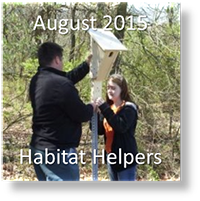
A habitat is the place in which a species is suited to live. It contains the food, water, shelter and space necessary for the species' survival. These components must be present in the proper amount and arrangement. The amount of suitable habitat generally determines the variety of species and the number of individuals that can live in an area. If the habitat needs for a species are not available in an area, the members of that species must move to an area that does meet their survival needs, or they will die.
Habitat requirements may be similar, but they are unique for each species. For example, insects, birds, mammals, frogs, fungi, spiders and other species, including plants, may live on or in a tree at the same time. Each species performs a different function, though, and has different needs. They may live at different heights in the tree. They may eat different things. They may be active at different times during the day. They are all finding what they need to survive and living together.
Biodiversity is the variety of life. About 54,000 species have been identified as living in Illinois, not counting bacteria. This great variety of life is due to the many habitat types in the state.
Habitats continually change, and a habitat with many species is more likely to adapt to and survive changes than one with a few types of organisms. There is a limit to how many individuals and species a habitat can support at one time. Known as carrying capacity, the limit is determined by the quality and quantity of habitat available. By changing any of the available food, water, shelter or space or their arrangement, the carrying capacity is affected. If the carrying capacity is decreased, some individuals must leave or die. If the carrying capacity is increased, more individuals can move into the area. Carrying capacity can change naturally and by human influences.
The habitat factor in least supply is the limiting factor. It controls population size. For example, if you want to help the eastern bluebird (Sialia sialis) population, you can develop a habitat to attract insects for them to eat and provide a constant source of water, but if there are no dead trees or other cavities for them to nest in, they will not stay in the area. The availability of nesting habitat is the limiting factor in this example.
In Illinois, soils, topography, drainage and climate determine the types of natural communities present in an area. Illinois has four main types of habitats: aquatic; woodland; grassland/prairie; and urban. Each of these habitats has its own characteristics and supports species adapted to it.
What can you do to be a Habitat Helper!?
Loss and degradation of wildlife habitat are serious problems in Illinois. Habitats can change by natural means or by human influences. Human actions are often detrimental to wildlife habitat, but humans can also take positive actions for wildlife.
- Plant native plants in your yard, school grounds and on public property. Native plants are adapted to Illinois' climate and can withstand drought, disease and insect attacks. They developed with our native animals and provide food and shelter for them. Select species that flower or fruit at different times of the year to provide food for several months.
- Provide nesting, roosting and den boxes for animal species.
- Leave dead trees standing, when possible, to provide food, shelter and nesting/roosting habitat.
- Before clearing an area of vegetation, consider the effects of your actions on the wildlife living there.
- Make clean, fresh water available daily for wildlife.
- Provide brush piles and rock piles for shelter.
- Research the food and shelter requirements of species you are trying to assist and provide those requirements.
- Purchase hunting and fishing licenses/stamps and hunting and fishing equipment. Your investment in these items includes money dedicated to the conservation of fish and wildlife species.
- Plant a pollinator garden, butterfly garden, prairie garden, rain garden or hummingbird garden.
- Leave a few dead limbs in your yard for native bees to nest in.
- Provide bare patches of soil for ground-nesting bees.
- Develop a woodland, prairie, pond or wetland habitat.
- Don’t kill milkweeds.
- Don’t use chemicals unless necessary and if necessary use the least toxic ones possible.
- Take part in citizen-science projects.
- Educate others about wildlife habitat issues.
- Encourage land managers to increase native wildlife habitat.
- Support conservation efforts for wildlife, such as the Illinois Wildlife Preservation Fund.
- Provide dusting habitat and grit for birds.
- Participate in Christmas tree recycling.
- There are many other ways that you can help wildlife, too.
Be a Habitat Helper! and make a positive difference for wildlife!

